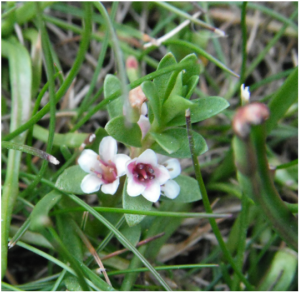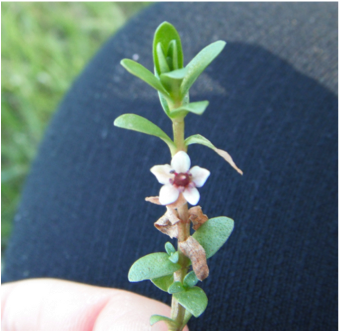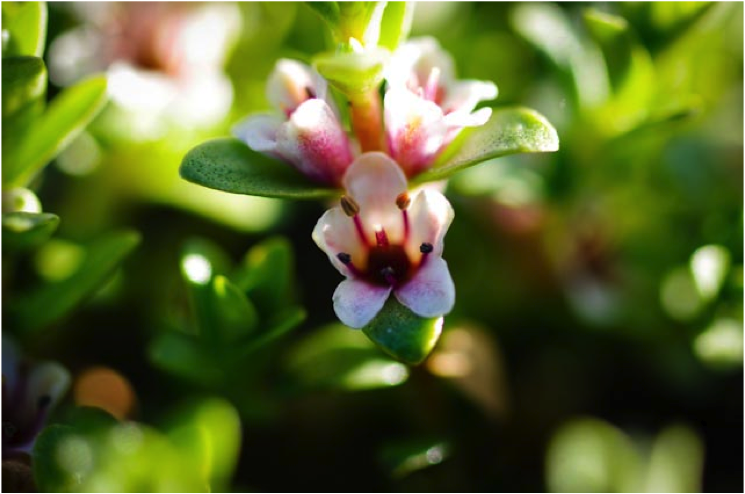Sea milk-wort • Glaux maritima ssp. optusifolia
{Glaux comes from the Greek word glaucos which means bluish-green, and maritima is latin for 'of the sea'.}
Identification
Sea milk-wort is a hairless fleshy perennial which grows 3-30 cm tall. The stem is thick and leafy right to the tip, with flowers growing along the entire length. Leaves are opposite low on the stem and become alternate further up. They are oval to oblong in shape, rather stiff, and grow 5-25 mm long. The small 4-5 mm wide five-petaled flowers are white with a blush of pink near the petal base.
Habitat & Range
Sea milk-wort is commonly found in tide flats, coastal marshes, interior alkaline marshes and wet inland meadows. It's range spans coastal BC, and also is widespread in the arctic and temperate North America.
Similar Species
Scarlet pimpernel (Anagallis arvensis) is a similar plant found in habitats common to the sea milk-wort. Scarlet pimpernel has pointed leaves, salmon-coloured flowers, and long curving stalks which distinguish it from the rounded leaves, pinkish-white flowers, and upright stems of the sea milk-wort.
Human Uses
Some coastal tribes brewed a tea from the sea milk-wort to drink in the evenings. It produced narcotic-like effects such as relaxation and sleepiness. An infusion of this plant was given to nursing mothers to increase their milk supply, which is how Glaux maritima got it's common name.
Sea milk-wort is a hairless fleshy perennial which grows 3-30 cm tall. The stem is thick and leafy right to the tip, with flowers growing along the entire length. Leaves are opposite low on the stem and become alternate further up. They are oval to oblong in shape, rather stiff, and grow 5-25 mm long. The small 4-5 mm wide five-petaled flowers are white with a blush of pink near the petal base.
Habitat & Range
Sea milk-wort is commonly found in tide flats, coastal marshes, interior alkaline marshes and wet inland meadows. It's range spans coastal BC, and also is widespread in the arctic and temperate North America.
Similar Species
Scarlet pimpernel (Anagallis arvensis) is a similar plant found in habitats common to the sea milk-wort. Scarlet pimpernel has pointed leaves, salmon-coloured flowers, and long curving stalks which distinguish it from the rounded leaves, pinkish-white flowers, and upright stems of the sea milk-wort.
Human Uses
Some coastal tribes brewed a tea from the sea milk-wort to drink in the evenings. It produced narcotic-like effects such as relaxation and sleepiness. An infusion of this plant was given to nursing mothers to increase their milk supply, which is how Glaux maritima got it's common name.
References
Pojar, J. and MacKinnon, A. (1994). Plants of Coastal British Columbia. Vancouver, BC: Lone Pine Publishing. P. 321.
Glaux maritima L. In Klinkenberg, Brian. (Ed.). E-Flora BC: Electronic Atlas of the Plants of British Columbia. Lab for Advanced Spatial Analysis, Department of Geography, University of British Columbia, Vancouver. Accessed 4/12/2014.
Anagallis arvensis L. In Klinkenberg, Brian. (Ed.). E-Flora BC: Electronic Atlas of the Plants of British Columbia. Lab for Advanced Spatial Analysis, Department of Geography, University of British Columbia, Vancouver. Accessed 4/12/2014.
Authors and editors of page
Paige Whitehead and Brian Starzomski (2014).
Pojar, J. and MacKinnon, A. (1994). Plants of Coastal British Columbia. Vancouver, BC: Lone Pine Publishing. P. 321.
Glaux maritima L. In Klinkenberg, Brian. (Ed.). E-Flora BC: Electronic Atlas of the Plants of British Columbia. Lab for Advanced Spatial Analysis, Department of Geography, University of British Columbia, Vancouver. Accessed 4/12/2014.
Anagallis arvensis L. In Klinkenberg, Brian. (Ed.). E-Flora BC: Electronic Atlas of the Plants of British Columbia. Lab for Advanced Spatial Analysis, Department of Geography, University of British Columbia, Vancouver. Accessed 4/12/2014.
Authors and editors of page
Paige Whitehead and Brian Starzomski (2014).






